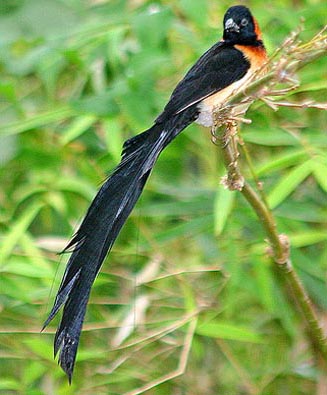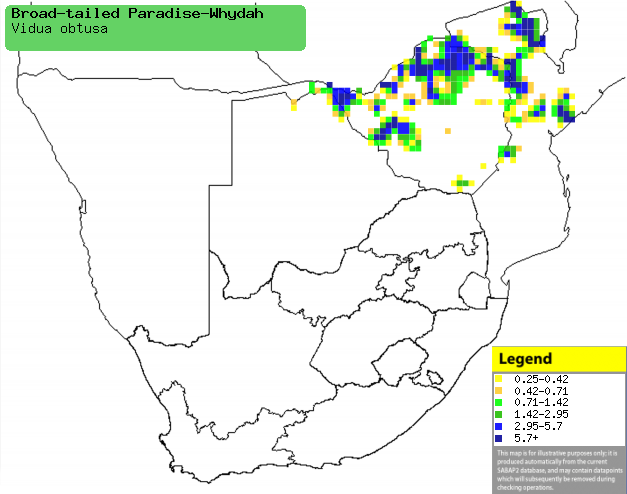|
Vidua obtusa (Broad-tailed
paradise-whydah)
BreŽstertparadysvink [Afrikaans]; Harusira (generic term
for whydahs) [Kwangali]; Nyambubundu (also applied to Long-tailed whydah) [Shona];
Breedstaart-paradijswida [Dutch]; Veuve de Chapin [French];
Breitschwanz-paradieswitwe [German]; Viķva-do-paraŪso-de-cauda-larga
[Portuguese]
Life
> Eukaryotes >
Opisthokonta
> Metazoa (animals) >
Bilateria >
Deuterostomia > Chordata >
Craniata > Vertebrata (vertebrates) > Gnathostomata (jawed
vertebrates) > Teleostomi (teleost fish) > Osteichthyes (bony fish) > Class:
Sarcopterygii (lobe-finned
fish) > Stegocephalia (terrestrial
vertebrates) > Tetrapoda
(four-legged vertebrates) > Reptiliomorpha > Amniota >
Reptilia (reptiles) >
Romeriida > Diapsida > Archosauromorpha > Archosauria >
Dinosauria
(dinosaurs) > Saurischia > Theropoda (bipedal predatory dinosaurs) >
Coelurosauria > Maniraptora > Aves
(birds) >
Order: Passeriformes > Family: Viduidae
 |
|
|
Broad-tailed paradise-whydah male, London Zoo, UK.
[photo Graham Smith ©] |
|
Distribution and habitat
Occurs from Uganda through Tanzania, southern DRC, Angola
and Zambia to southern Africa. Here it is locally common in central and northern
Mozambique, Zimbabwe, north-eastern Botswana and the Caprivi Strip (Namibia),
generally preferring miombo (Brachystegia) and other broad-leaved
woodland types, especially with grassy vegetation along drainage lines with
nearby fallow cultivated fields.
|
 |
|
Distribution of Broad-tailed paradise-whydah in southern Africa,
based on statistical smoothing of the records from first SA Bird Atlas
Project (©
Animal Demography unit, University of
Cape Town; smoothing by Birgit Erni and Francesca Little). Colours range
from dark blue (most common) through to yellow (least common). |
Food
It mainly eats grass seeds taken from the ground, sometimes
joining mixed-species foraging flocks along with other whydah species. The following food items have been recorded
to be eaten in captivity:
- Grass seeds
- Panicum maximum (Guinea grass)
- Panicum shinzii (Sweet grass)
- Hyparrhenia hirta (Common thatching grass)
Breeding
- It is a polygynous brood parasite, with only one known host -
Pytilia afra
(Orange-winged pytilia).
- It lays 1 egg per day in sets of three, taking a few days break between
sets; egg-laying season is mainly from February-March.
- The chicks hatch after about 12-13 days of incubation and are reared
alongside Orange-winged pytilia chicks, often fledging together in a mixed
brood.
Threats
Not threatened.
References
-
Hockey PAR, Dean WRJ and Ryan PG 2005. Roberts
- Birds of southern Africa, VIIth ed. The Trustees of the John Voelcker
Bird Book Fund, Cape Town.
|
